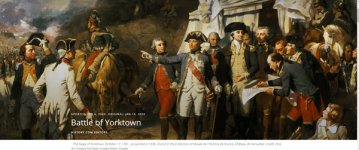Thank you, France for then, now, and always, Thank you!
By mid-September 1781, Washington and Rochambeau arrived in Williamsburg, Virginia, 13 miles from the tobacco port of Yorktown, where Cornwallis’s men had built a defense of 10 small forts (a.k.a. redoubts) with artillery batteries and connecting trenches. In response, Cornwallis asked Clinton for aid, and the general promised him a fleet of 5,000 British soldiers would set sail from New York to Yorktown.
With a small force left in New York, about 2,500 Americans and 4,000 French soldiers—facing some 8,000 British troops—began digging their own trenches 800 yards from the Brits and started a nearly week-long artillery assault on the enemy on October 9.
“The heavy cannons pounded the British mercilessly, and by October 11 had knocked out most of the British guns,” the Army Heritage Center Foundation states. “Cornwallis received the unfortunate (for him) news that Clinton's departure from New York had been delayed.”

General Cornwallis Surrenders
Of his 400 infantrymen, Hamilton lost just nine in the attack, with some 30 wounded, while the 400 French-led troops lost 27 men, with 109 wounded, according to Fleming. Surrounded by enemy fire, and blocked from receiving aid by the French fleet that had arrived in Chesapeake Bay, Cornwallis was trapped.
The successful siege allowed the allies to complete the second parallel trench and “snuffed out the last remains of resistance among the British.” In a final effort on October 16, Cornwallis attempted a nighttime sea evacuation, but he was stopped by a storm.
On the morning of October 17, the British sent forward a red-coated drummer boy, followed by an officer waving a white handkerchief to the parapet. All guns fell silent—Cornwallis had surrendered.
Tobys Notes: To me Italy is the holiest city in the world. Paris is the most beautiful.
The USA the greatest gasp God ever had.





 oknovokght.net
oknovokght.net